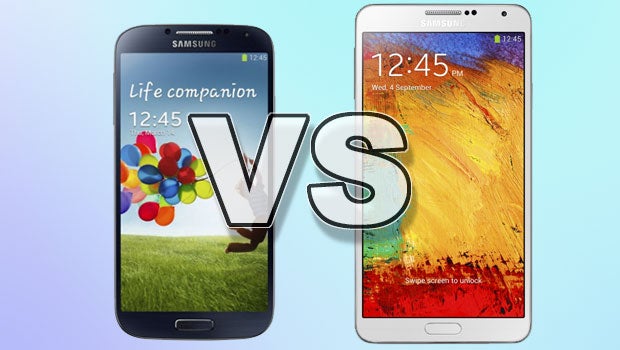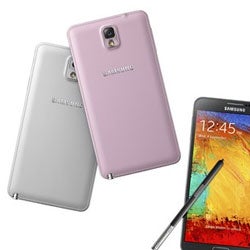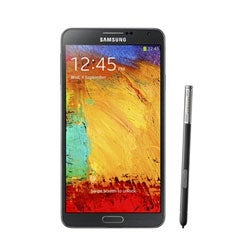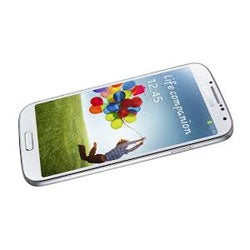Samsung Galaxy S4 vs Galaxy Note 3

The Samsung Galaxy Note 3 is official. It improves upon the previous Note 2 in virtually every way imaginable.
But is it any better than the Samsung Galaxy S4, an Android demigod? We’ve broken it down to see which is really the better phone.
Samsung Galaxy S4 vs Note 3 – Design
Galaxy S4 – glossy plastic rear, 130g, 7.9mm thick, 70mm wide
Galaxy Note 3 – leather effect rear, 168g, 8.3mm thick, 79mm wide
After years of complaints, Samsung has finally gotten rid of the glossy plastic battery covers used in just about all of its Galaxy-series Android phones. The Samsung Galaxy S4 has one, but the Galaxy Note 3 uses a brand new style of rear.
 It’s still a removable cover, but it has a leather-like texture that is much grippier and easier on the fingers than the glossy plastic of old. To give it that handmade look, the back cover also has faux stitching around its edge. It’s like a phone from Etsy, sort of.
It’s still a removable cover, but it has a leather-like texture that is much grippier and easier on the fingers than the glossy plastic of old. To give it that handmade look, the back cover also has faux stitching around its edge. It’s like a phone from Etsy, sort of.
As a much larger phone, the Note 3 is predictably a lot wider and heavier than the S4. However, it’s not disastrously so. It’s 9mm wider than the Galaxy S4, and 38g heavier. That makes it a shade lighter than the Note 2, and a smidge slimmer.
Samsung has done this by cleverly reducing the screen bezel so that the Note 3 is almost all-screen. Of course – so is the Galaxy S4. Samsung has had to be a bit more aggressive in the new Note, though, giving it a boxier front profile than the curvy Galaxy S4.
The Note 3 is a little thicker than the Galaxy S4 – 8.3mm against 7.9mm – but we don’t think 0.4mm is worth worrying about too much.
Samsung Galaxy S4 vs Note 3 – Screen
Galaxy S4 – 5-inch 1080p Super AMOLED screen (diamond PenTile)
Galaxy Note 3 – 5.7-inch 1080p Super AMOLED with digitiser layer
Continuing a long-running trend of top-end Galaxy phones, both the Galaxy S4 and Galaxy Note 3 use Super AMOLED displays. This kind of screen does not use the universal backlight of LCD, but has light-emitting pixels, letting the dark areas of an image stay super-dark.
Contrast and black levels in both phones are excellent. As is sharpness. Both phones use a 1080p panel.
As the Galaxy S4 has a smaller screen, pixel density is naturally higher – 440ppi to the Note 3’s 386ppi. Does it matter? Not really, as both displays are extremely sharp. We’re looking for clarification on the exact type of sub pixel array the Note 3 uses, but as the Galaxy S4 uses a diamond-shaped PenTile array, the Note 3 could potentially be even sharper in person.
 For tasks like watching videos, browsing the web or playing games, the extra screen space of the Note 3 makes it the better display. It really is luxuriously large.
For tasks like watching videos, browsing the web or playing games, the extra screen space of the Note 3 makes it the better display. It really is luxuriously large.
It is also more advanced. It packs in an extra digitiser layer that the Galaxy S4 lacks. This is what enables the S Pen stylus functionality you get with a Note phone.
It’s a Wacom digitiser than can sense varying levels of pressure applied by the S Pen, which slots into the bottom edge of the Note 3. The capacitive screen of the Galaxy S4 cannot sense varying levels of pressure.
Samsung Galaxy S4 vs Note 3 – Software
Galaxy S4 – Android 4.2 with TouchWiz
Galaxy Note 3 – Android 4.3 with TouchWiz and stylus implementation
Samsung has packed a load of stylus S Pen enhancements into the Note 3, but otherwise it uses a very similar software suite to the Galaxy S4. It uses Android as its base, and lays the TouchWiz user interface on top.
TouchWiz offers a bright and breezy look, and adds zillions of features to Android. Some might say it offers too many.
For a closer look at some of them, read our 10 new TouchWiz features article
There are some differences, though. The Galaxy Note 3 uses Android 4.3 as its base where the Galaxy S4 is stuck with Android 4.2. You can bet it’ll get the bump-up in time, but for now the Note 3 is slightly more up-to-date.
Android 4.3 improves the basic security of the Android system, brings a number of performance optimisations and lets you resize widgets freely. It’s no huge loss though as it’s TouchWiz, rather than Android, that generally determines what a Galaxy-series phone feels like to use.
Samsung Galaxy S4 vs Note 3 – S Pen vs no S Pen
Galaxy S4 – No digitiser, no stylus
Galaxy Note 3 – S Pen, 1,024 pressure levels (TBC)
Here’s the biggie – to S Pen or not to S Pen? The Galaxy S4 does not have an S Pen, and will not work with one if even if you buy one separately. It just doesn’t have the hardware to support it.
The S Pen is a digitiser stylus that ‘talks to’ a special layer in the Note 3’s screen. It can sense the pen before it even touches the display, can determine how hard you’re pressing on the screen and gives a very realistic hand-drawing/writing experience.
Samsung has reworked the software of the S Pen too, using something called Air Command. This is not a military thing, but a little circular nav bar that pops-up on-screen when you press a button on the S Pen stylus. It gives you access to all the most common S Pen apps, as well as some core features like the phone search.
We love the S Pen. You might not use it a great deal, but it’s a worthwhile feature and is a rare example of Samsung adding something to a phone that really adds something to the experience.
Samsung Galaxy S4 vs Note 3 – CPU and RAM
Galaxy S4 – Quad-core 1.9GHz Snapdragon 600, 2GB RAM
Galaxy Note 3 – Quad-core 2.3GHz Snapdragon 800, 3GB RAM
 There’s a generational divide between the Galaxy S4 and the Note 3 in terms of power – one uses the Snapdragon 600, the other a newer Snapdragon 800 chip. Benchmarks show that the Snapdragon 800 is significantly more powerful, in part down to the supercharged 2.3GHz clock speed of the Note 3.
There’s a generational divide between the Galaxy S4 and the Note 3 in terms of power – one uses the Snapdragon 600, the other a newer Snapdragon 800 chip. Benchmarks show that the Snapdragon 800 is significantly more powerful, in part down to the supercharged 2.3GHz clock speed of the Note 3.
It’s not just the clock speed, though. Snapdragon 800 uses updated Krait 400 cores, as opposed to the Krait 300 cores of the Galaxy S4’s Snapdragon 600. The GPU has been updated too, from an Adreno 320 to an Adreno 330. But what do all these numbers really mean?
Without delving into the specs, the new CPU/GPU cores offer an incremental speed increase that means the Note 3 will comfortably outperform the UK version of the Galaxy S4. However, it’s a close-run thing between the Note 3 and the Octa-core version of the Galaxy S4 seen in some other parts of the world.
We’ll wait to perform our own benchmarks before coming to any firm conclusions.
Samsung Galaxy S4 vs Note 3 – Storage
Galaxy S4 – 16/32/64GB (mostly 16GB in UK), microSD
Galaxy Note 3 – 32/64GB, microSD
As with just about every Galaxy-series phone, both the Galaxy S4 and the Note 3 have a microSD memory card, letting you add to their internal memory easily and cheaply. microSD cards are dirt cheap these days.
Where the lowest-end model of the Galaxy S4 has 16GB of internal memory, the Note 3 starts out at 32GB. This is likely to help soften the blow of quite how expensive it’ll be. Looking at its specs, we can’t imagine it’ll sell for much less than £600 on day one.
Both phones max-out at 64GB internal storage, however the 64GB Galaxy S4 is not widely available in the UK. In the same vein, it’s likely that the 32GB edition of the Note 3 will be the most common one on shelves.
Samsung Galaxy S4 vs Note 3 – Cameras
Galaxy S4 – 13-megapixel sensor with LED flash, 2-megapixel front camera
Galaxy Note 3 – 13-megapixel sensor with LED flash, 2-megapixel front camera, 4K video capture
One area where the Galaxy S4 and Note 3 are almost level-pegging is camera tech. They have 13-megapixel cameras, seemingly using the same Sony-made sensor. Both also have an LED flash and 2-megapixel front cameras.
They’re near-identical. However, there is one software bonus that the Note 3 can brag about. It can capture video in 4K resolution from its main 13-megapixel camera – the Galaxy S4 is stuck with 1080p.
We imagine this is a feature that could be implemented in the Galaxy S4 through a software update, unless it really needs the extra power of the Snapdragon 800 chip and its extra 1GB of system RAM. We’re not convinced it would.
Image quality of both cameras in good lighting should be excellent – the Samsung Galaxy S4 can produce some cracking shots. However, as their sensors are pretty teeny, neither is going to be too great at low-light photography.
Samsung Galaxy S4 vs Note 3 – Battery Life
Galaxy S4 – 2,600mAh battery
Galaxy Note 3 – 3,200mAh battery
A larger screen needs a larger battery – and that’s just what the Note 3 has. It has a 3,200mAh battery, 100mAh higher-capacity than the battery of the Galaxy Note 2.
The Galaxy S4 has a 2,600mAh battery, which is roughly in-line with what we’d expect from a phone that’s 0.7 inches smaller. However, we were impressed with the battery stamina of the Note 2, so perhaps its successor will do the same.
We’ll be back with more battery comparisons once we’ve had some more time to play with the new Galaxy Note 3.
Verdict
The Samsung Galaxy Note 3 may be a conservative upgrade in some respects, but technologically it’s easily the most impressive phone in the Galaxy line-up. It makes the Galaxy S4 look a little past-it.
Is it a sign of what’s to come in the Galaxy S5? Not really, as we expect further tech innovations in that phone. However, the Note 3 is a cracking device that deserves a lot of attention if the idea of a digitiser stylus appeals.
Next read our Note 3 vs Note 2 comparison


